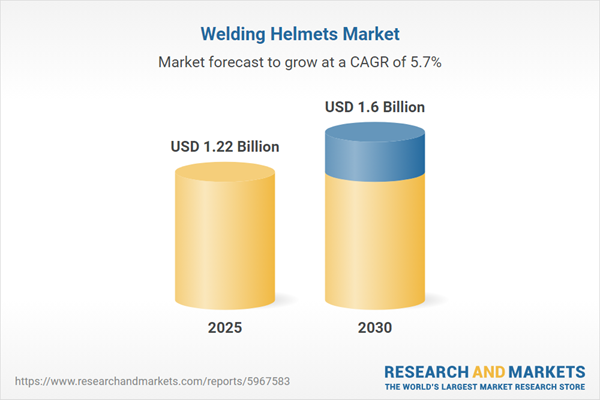Speak directly to the analyst to clarify any post sales queries you may have.
The welding helmets market is evolving rapidly, shaped by advanced safety mandates, digital innovations, and the growing complexity of manufacturing needs worldwide. Market leaders and new entrants alike are aligning product development and strategic direction to meet escalating regulatory requirements and leverage industry 4.0 capabilities.
Welding Helmets Market Snapshot
The welding helmets market grew from USD 1.15 billion in 2024 to USD 1.22 billion in 2025, with projections indicating ongoing expansion at a CAGR of 5.65% to reach USD 1.60 billion by 2030. This consistent growth highlights surging demand for connected protective equipment and increased adoption across industrial end-users worldwide.
Scope & Segmentation
This report delivers comprehensive coverage across core product types, technologies, and end-user segments:
- Welding Processes: Includes Gas Metal Arc Welding (MIG), Gas Tungsten Arc (TIG), and Shielded Metal Arc methodologies.
- Style: Assesses flip-up, full-face, and half-mask helmet configurations tailored for varying operational needs.
- Lens Shade: Evaluates both fixed and variable shade solutions, emphasizing adaptability and safety for diverse welding tasks.
- Material: Reviews options such as acrylonitrile butadiene styrene, fiberglass, nylon-based, and polycarbonate constructions.
- Power Source: Explores battery-powered, solar-powered, and non-powered models, examining maintenance and feature trade-offs.
- End User Industry: Covers aerospace, automotive, construction, electrical & electronics, mining, oil & gas, and shipbuilding sectors, reflecting distinct priorities and adoption rates.
- Distribution Channel: Breakdown includes offline (direct sales, distributors) and online (e-commerce platforms, manufacturer websites) routes.
- Geographic Regions: Analysis spans the Americas (United States, Canada, Latin America), Europe, the Middle East & Africa (including major European, Middle Eastern, and African economies), and Asia-Pacific, with special attention to regional industrialization and safety climates.
- Company Profiles: Features developments from key players such as 3M Company, ESAB Corporation, Honeywell International, Lincoln Electric Holdings, Fronius International GmbH, and others.
Key Takeaways
- New safety regulations are prompting continual product enhancements, including the adoption of auto-darkening filters, advanced ventilation, and ergonomic materials.
- Integration of smart technologies such as wireless connectivity, heads-up displays, and digital performance analytics is redefining value propositions in premium helmet models.
- Modular helmet designs and sustainable material selection respond to growing demand for customization and environmental responsibility across multiple end-user segments.
- Industry 4.0 principles are elevating operational transparency, with connected helmets enabling real-time safety management and predictive maintenance for industrial enterprises.
- Strategic alliances between manufacturers, materials science innovators, and robotics firms are underpinning technology shifts, especially in automated and collaborative welding environments.
Tariff Impact on the Welding Helmets Market
The implementation of new U.S. tariffs in 2025 has increased input costs for imported materials, compelling manufacturers to realign supply chains and prioritize partnerships with domestic suppliers. These policy changes are accelerating the search for alternative composites and fostering collaborative research to address component sourcing and long-term innovation strategies.
Welding Helmets Market Research Methodology
Report findings are built upon mixed-methods research, incorporating interviews with sector executives, distributor managers, and safety professionals. Triangulated with secondary sources, including regulatory reviews and patent analysis, the methodology ensures reliable, actionable insights and robust cross-validation of observed trends.
Why This Report Matters
- Enables strategic planning by illuminating technological, regulatory, and supply chain factors that directly impact decision-making within protective equipment markets.
- Identifies new growth opportunities and risk factors—such as tariff fluctuations and digital integration—essential for proactive capital allocation and innovation management.
- Equips decision-makers with segmentation and regional insights to support tailored go-to-market strategies and operational resilience.
Conclusion
The welding helmets market is transitioning toward smarter, connected, and more sustainable solutions. Companies that prioritize modular design, regional supply-chain resilience, and digital integration will be positioned to thrive as industry requirements continue to advance.
Additional Product Information:
- Purchase of this report includes 1 year online access with quarterly updates.
- This report can be updated on request. Please contact our Customer Experience team using the Ask a Question widget on our website.
Table of Contents
3. Executive Summary
4. Market Overview
7. Cumulative Impact of Artificial Intelligence 2025
Companies Mentioned
The companies profiled in this Welding Helmets market report include:- 3M Company
- ESAB Corporation
- Honeywell International Inc.
- Hypertherm, Inc.
- Illinois Tool Works Inc.
- INGCO Inc.
- Kemppi Oy
- Lincoln Electric Holdings, Inc.
- Ningbo Geostar PhotoElectric Technology Co.,Ltd.
- Portwest UC
- Riken Optech Corporation
- SAS GYS
- Walter Surface Technologies Inc.
- Wuhan Welhel Photoelectric Co., Ltd.
- YesWelder by Weldmart Inc.
- SureWerx Inc.
- MITCO WELD PRODUCTS PVT. LTD.
- JSP Limited
- MSA Safety Incorporated
- Shenzhen JASIC Technology Co., Ltd.
- Delta Plus Group SA
- DeWalt by JS Products Inc.
- Fronius International GmbH
- OPTREL AG
- Bolle Safety Inc.
- GVS-RPB
- Alexander Binzel Schweisstechnik GmbH & Co. KG
- Forney Industries, Inc.
- Sunstone Engineering LLC
- SENLISWELD
- ArcOne
Table Information
| Report Attribute | Details |
|---|---|
| No. of Pages | 196 |
| Published | November 2025 |
| Forecast Period | 2025 - 2030 |
| Estimated Market Value ( USD | $ 1.22 Billion |
| Forecasted Market Value ( USD | $ 1.6 Billion |
| Compound Annual Growth Rate | 5.6% |
| Regions Covered | Global |
| No. of Companies Mentioned | 32 |









